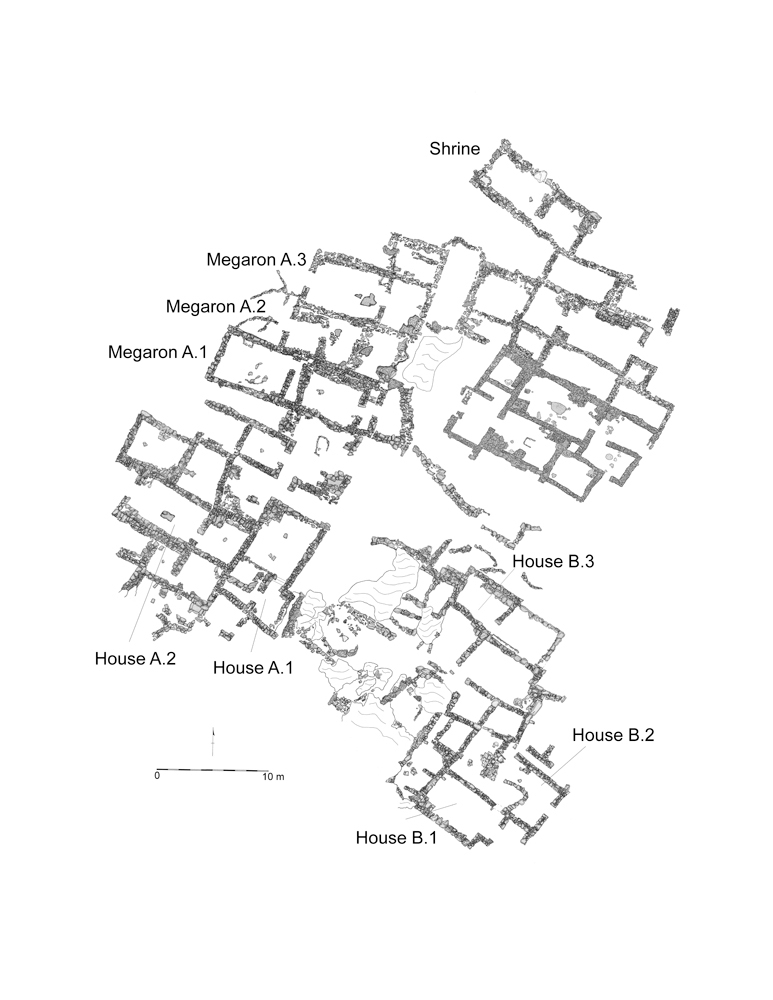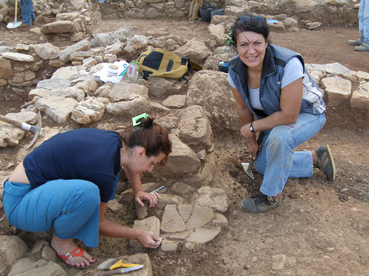The Late Minoan (LM) IIIC settlement of Chalasmenos is located on a low hill (240 m above sea level) immediately to the south of the Cha Gorge near the village of Monastiraki in eastern Crete. Excavations started in 1992 (and lasted until 2014) as a collaboration (synergasia) between the American School of Classical Studies at Athens (ASCSA) and the Hellenic Ministry of Culture under the direction of Metaxia Tsipopoulou and the late William D.E. Coulson.

The settlement was relatively large for the period, comprised of an estimated 4,000 m², and it provides evidence for a degree of urban planning. The site was divided into four quarters, which were separated by roughly paved pathways, and an open, triangular-shaped area (plateia) occupied the center of the settlement (a contemporary kiln was also found at the northern end of this open area).

A communal shrine containing numerous ceramic figures of the type called “goddess with upraised arms,” snake tubes, plaques, kalathoi, and pithoi was found at the northeastern edge of the site.

While the majority of the structures at Chalasmenos, such as Houses A.1 and A.2, appear to have been primarily domestic in nature, special functions have been assigned to certain buildings, including Megara A.1–A.3 at the northwest, which may have been used for communal feasting, possibly serving different clans, rather than as residences. In addition, Houses B.1 and B.2 (and possibly also B.3) in the southeastern part of the site have been interpreted by Tsipopoulou as kitchens and storage for large-scale food preparation (perhaps for the feasting that took place in Megara A.1–A.3), based on the evidence of multiple hearths and very large cooking pots.

The settlement of Chalasmenos had only one primary phase of use; it was occupied for a short period of time within the 12th c. B.C. before being peacefully abandoned. A small tholos tomb, also LM IIIC in date, has been excavated by the road leading to the site. There was limited activity in the Protogeometric period, consisting of a single deposit in a small exterior shrine associated with House A.1 and a possible tholos tomb constructed in the ruins of House B.1. Also, in the Late Geometric period, a rectangular structure showing evidence of ritual dining was built partially on top of the large LM IIIC Megaron A.1.

The site is fenced but unguarded and open to the public, though there are no signs. A dirt road (which branches off the asphalt road leading to the upper part of the village of Monastiraki) leads directly to the site.
Selected References
Coulson, W., and M. Tsipopoulou. 1994. “Preliminary Investigations at Halasmenos, Crete, 1992–93,” Aegean Archaeology 1, pp. 65–97.
Eaby, M. 2018. Chalasmenos I. The Late Minoan IIIC Settlement: House A.2 (Prehistory Monographs 59), Philadelphia.
Tsipopoulou, M. 2004. “Halasmenos, Destroyed but Not Invisible: New Insights on the LM IIIC Period in the Isthmus of Ierapetra. First Presentation of the Pottery from the 1992–1997 Campaigns,” in Crete beyond the Palaces. Proceedings of the Crete 2000 Conference (Prehistory Monographs 10), L.P. Day, M.S. Mook, and J.D. Muhly, eds., Philadelphia, pp. 103–123.
———. 2005. “‘Mycenoans’ at the Isthmus of Ierapetra: Some (Preliminary) Thoughts on the Foundation of the (Eteo)Cretan Cultural Identity,” in Ariadne’s Threads. Connections between Crete and the Greek Mainland in Late Minoan III (LM IIIA2 to LM IIIC). Proceedings of the International Workshop Held at Athens Scuola Archeologica Italiana, 5-6 April 2003 (Tripodes 3), A.L. D’Agata and J. Moody, eds., Athens, pp. 303–333.
———. 2009. “Goddesses for “Gene”? The Late Minoan IIIC Shrine at Halasmenos, Ierapetra,” in Archaeologies of Cult. Essays on Ritual and Cult in Crete in Honor of Geraldine Gesell (Hesperia Suppl. 42), A.L. D’Agata and A. Van de Moortel, eds., Princeton, pp. 121–136.
———. 2011a. “Chalasmenos, Ierapetra: “Mycenaeanizing” or Not at the End of the Bronze Age,” in ΣΤΕΓΑ: The Archaeology of Houses and Households in Ancient Crete (Hesperia Suppl. 44), K.T. Glowacki and N. Vogeikoff-Brogan, eds., Princeton, pp. 333–347.
———. 2011b. “Living at Halasmenos, Ierapetra, in Late Minoan IIIC. House A.1,” in The “Dark Ages” Revisited. Acts of an International Symposium in Memory of William D.E. Coulson, University of Thessaly, Volos, 14-17 June 2007, A. Mazarakis Ainian, ed., Volos, pp. 463–476.
